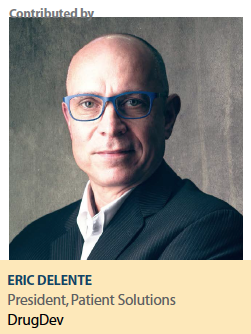 Imagine you’re applying for a new bank account. A bank associate guides you through forms, pointing at where your signature belongs. He’s got good intentions and wants to help, but speaks quickly with jargon and acronyms. You leave feeling cautiously optimistic, as you still have questions. Weeks later, you discover hidden fees — and wind up cancelling your account.
Imagine you’re applying for a new bank account. A bank associate guides you through forms, pointing at where your signature belongs. He’s got good intentions and wants to help, but speaks quickly with jargon and acronyms. You leave feeling cautiously optimistic, as you still have questions. Weeks later, you discover hidden fees — and wind up cancelling your account.
As consumers, this is an experience we’ve all had. As members of the clinical trials community, we have a responsibility to ensure it never happens to a patient. Unfortunately, 18% to 30% of patients in a clinical trial will drop out, and one of the most common reasons is an inferior consent process that did not set proper expectations up front.
With patient recruitment accounting for almost one-third of trial costs, patient retention is a multibillion-dollar problem. The challenge we face is how to educate patients and build trust equity during consent when we are not in direct control of the process. Electronic informed consent is the answer.
The Solution to Uncertainty
eConsent offers sponsors, sites, and investigators the ability to simplify and modernize the consent process. Patients begin by watching videos explaining clinical trials and what informed consent means. From there, they move through each section of the electronic consent form at their own speed. Patients have the freedom to enlarge fonts, listen to a narrator, and mark sections they don’t understand to spur conversations with qualified medical professionals at the site. Embedded in the process are additional videos, animations, and quizzes that are used to explain difficult concepts and help patients of all ages, cultures, languages and education levels retain trial information regardless of their exposure to technology.
Retaining the Patients
The result of all this is a system that is flexible, easy-to-understand, and ensures each patient finishes the consent process informed and with all questions answered. This is critical, as patients who truly understand what they’re consenting to, are more likely to finish the trial.
 A 2003 CenterWatch report measured the enrollment rates of two identical trials — one using eConsent and one using paper. The study found that eConsent significantly improved understanding of the trial, resulting in improved patient retention. In fact, the study surmised that simply using eConsent instead of paper meant sites would have to enroll 25% fewer patients to reach the same goal of patients completing the study, which would deliver staggering time and cost benefits on a global trial scale.
A 2003 CenterWatch report measured the enrollment rates of two identical trials — one using eConsent and one using paper. The study found that eConsent significantly improved understanding of the trial, resulting in improved patient retention. In fact, the study surmised that simply using eConsent instead of paper meant sites would have to enroll 25% fewer patients to reach the same goal of patients completing the study, which would deliver staggering time and cost benefits on a global trial scale.
Doing Things Paper Never Could
While these findings are great, no system or process should ever stand still. Thankfully, eConsent systems allow sites, sponsors, and investigators to learn and adapt to how patients understand the consent process. The best eConsent solutions do more than provide better education; they capture data that identify areas that patients commonly find confusing, where they slow down when reading, what sections they repeated, and other usability statistics.
Additionally, they include cutting-edge features like signature forensics, which measures the velocity, acceleration, and other metrics of a signature to authenticate it even when a patient is deliberately trying to alter their signature, and banking of biological samples through barcode scanning.
As eConsent gains traction in the industry these insights will allow us to better understand our patients and adapt to their needs. Even better, analyzing these trends across trials and implementing learned best practices will provide a better experience for patients enrolling in trials everywhere.
Adopt the Future
While eConsent looks promising for patients, its adoption rates still leave much to be desired. According to DrugDev’s 2016 Global Investigator Survey, only 28% of global sites have used eConsent before. The reason for such low adoption was eye-opening, as 77% of sites reported that they have never been asked to by their sponsors.
If we’re going to present ourselves as an industry that is patient-centric, then we must adopt technologies that make it easier for them to participate in our trials. That begins, naturally, at the beginning — by establishing a relationship of transparency and trust during the consent process. After all, the most important thing we stand to lose is the patient. (PV)
DrugDev is committed to providing sponsors, CROs, and sites with solutions that transform clinical research through collaboration, standardization, and a beautiful technology experience.
For more information, visit drugdev.com.











